Improved Conley Magazine Camera
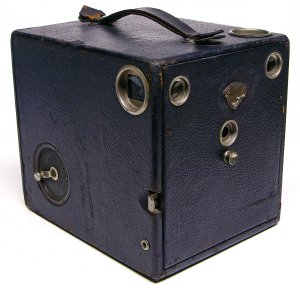
Format: 4x5
Medium: Dry plate
Lens type: fixed-focus, f.16
Shutter speeds: Timed and Instantaneous. About 1/50".
This absolutely massive box camera stored twelve pre-loaded glass plates (cut film sheaths were also available) which were advanced by means of a winder. A plate was exposed, the winder cranked, and the exposed plate dropped along a pair of guide rails to the bottom of the camera. A pressure spring pushed the next plate into place. A counter next to the winder kept track of one's exposures. The mechanism can be seen in the Model III cutout illustration below.
After all twelve plates were exposed, the back of the camera was opened in the darkroom and a catch released which opened a door in the bottom of the camera, allowing retrieval of the photos.
The shutter can be released by either the lever on the front right-hand side or by an optional bulb. The knob beneath the shutter chooses one of two aperture openings (f-stops unknown) or a solid lens cover.
Same camera as the Model III.
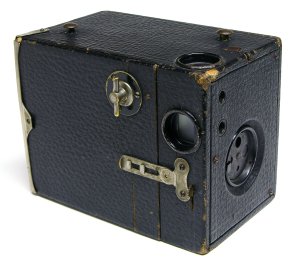
Format: 2 1/4 x 3 1/4 (6x9cm)
Medium: Roll film (120)
Lens type: fixed-focus
Shutter speeds: T/I. About 1/25"
The classic box camera, with a literal twist. The Kewpie differed from its Brownie/Buster Brown/Scout/etc cousins in two major ways. The most obvious was the rotating disk on the front of the camera that offered the option of four apertures. The second unique feature was the side-loading cone. Most box camera cones slide out the front or back. The Kewpie No. 2 has a front slide catch and one hinged rear catch (the other Kewpies have two separate sliding rear catches). When released, the whole side of the camera slides out. It's a little easier to remove and insert, but the edges of freshly-loaded film can catch on the sides if it's not wound tightly. A pull-up slide at the top permits timed exposures.
The shutter release lever trips the shutter each time it is moved, either up or down. Users used to other box cameras with an up-down style lever need to take care to not produce a double-exposure!
The four apertures, by the way, are f/14, f/16, f/22, f/32.
Later, Conley produced a folding version of the Kewpie. These are covered in the Folding cameras section.
Kewpie No. 2a
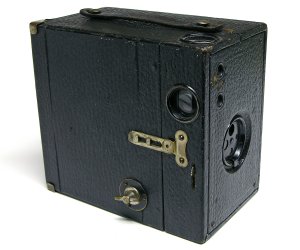
Format: 2 1/2 x 4 1/4
Medium: Roll film (116)
Lens type: fixed-focus
Shutter speeds: about 1/25"
The quickest way to recognize a Kewpie No. 2a is that it is the only Kewpie that has its winding key at the bottom.
Kewpie No. 2c
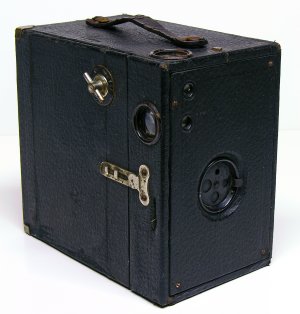
Format: 2 7/8 x 4 7/8
Medium: Roll film (130)
Lens type: fixed-focus
Shutter speeds: about 1/25 sec
The 2c was a nonstandard format which was produced for only a short time. The 2c does not appear in the 1916 catalog, nor the 1923 catalog.
Kewpie No. 3
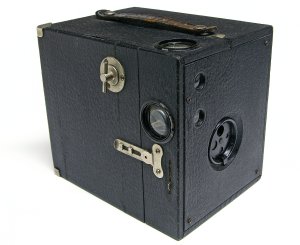
Format: 3 1/4 x 4 1/4
Medium: Roll film (122)
Lens type: fixed-focus
Shutter speeds: about 1/25"
By this model, the Kewpie is now so large that it comes equipped with side and bottom tripod sockets.
Kewpie No. 3a
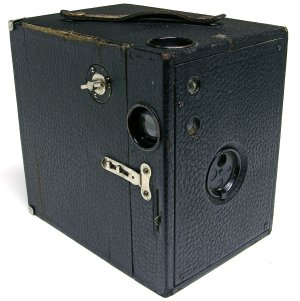
Medium: Roll film (125)
Lens type: fixed-focus
Shutter speeds: about 1/25"
Model I
(See Senior Box Camera)
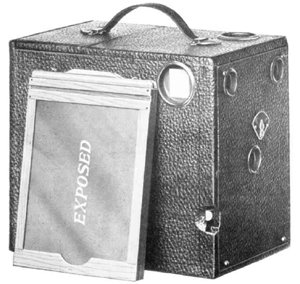
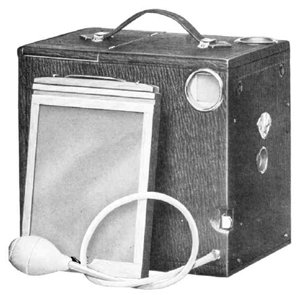
Model III
(see Improved Conley Magazine)
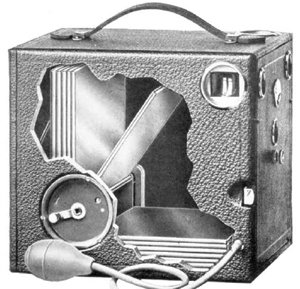
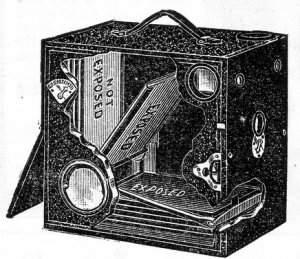
Format: 4x5, 3 1/4 x 4 1/4
Medium: Dry plate
Lens type: fixed-focus
As illustrated in an 1899 McClure's magazine ad, this is the earliest known retail version of the Conley brothers' original magazine camera design. The frame counter appears to be the same piece that would be used for the T/I setting on the front of later versions, while the shutter setting device is situated underneath the lens rather than above. It was only available leatherbound. A color screen (yellow, one must presume) and shutter lock were available as options for a $2 upgrade, something none of the later magazine cameras featured.
It's worth noting that while the ad places the factory in Spring Valley, MN, it gives the company headquarters as Minneapolis.
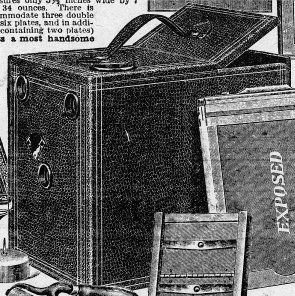
Format: 4x5
Medium: Dry plate
Lens: Fixed-focus, f.16
Shutter: T/I (about 1/50")
Similar in operation to the Improved Conley Magazine/Model III, but with only single-shot capability. The rear top is lifted, a plate holder is inserted much like any other plate camera, the exposure made, and the plate holder removed and the next one inserted. This type of camera is sometimes erroneously referred to as a magazine camera due to its ability to store three plate holders in the rear compartment, but there is no mechanical film advancement like the true magazine cameras have.